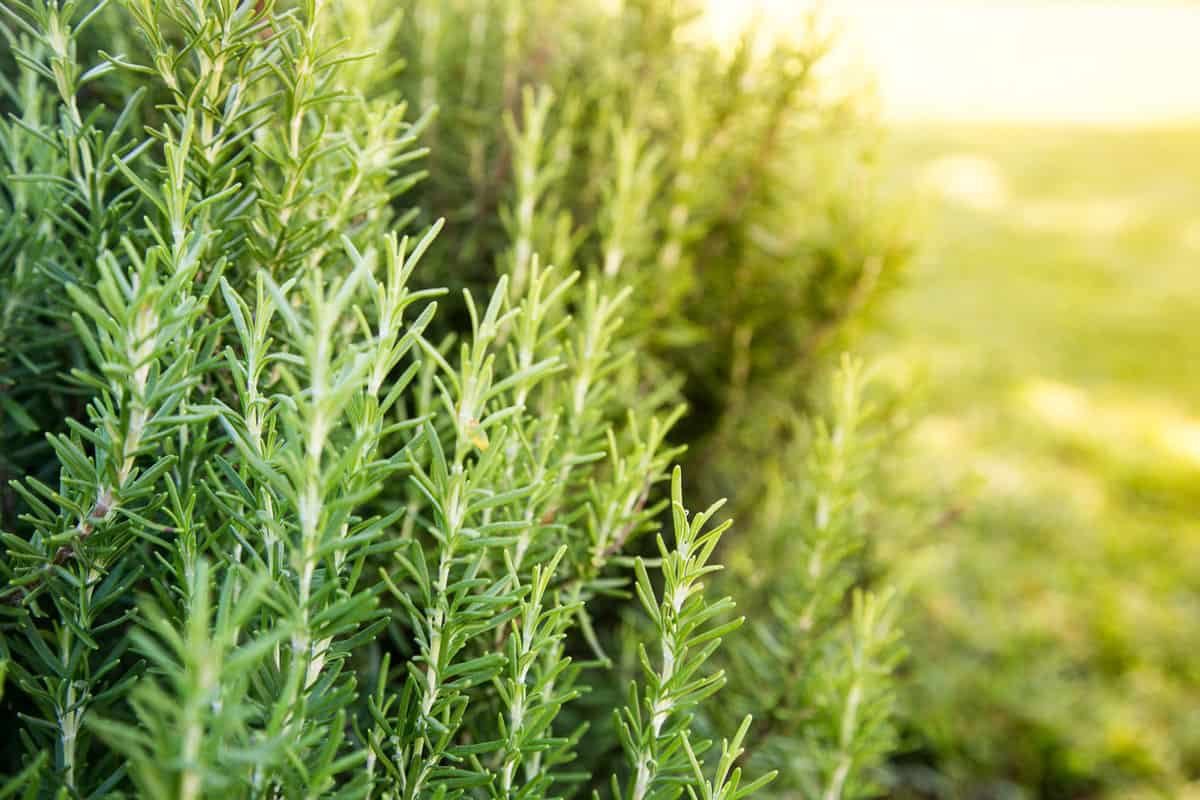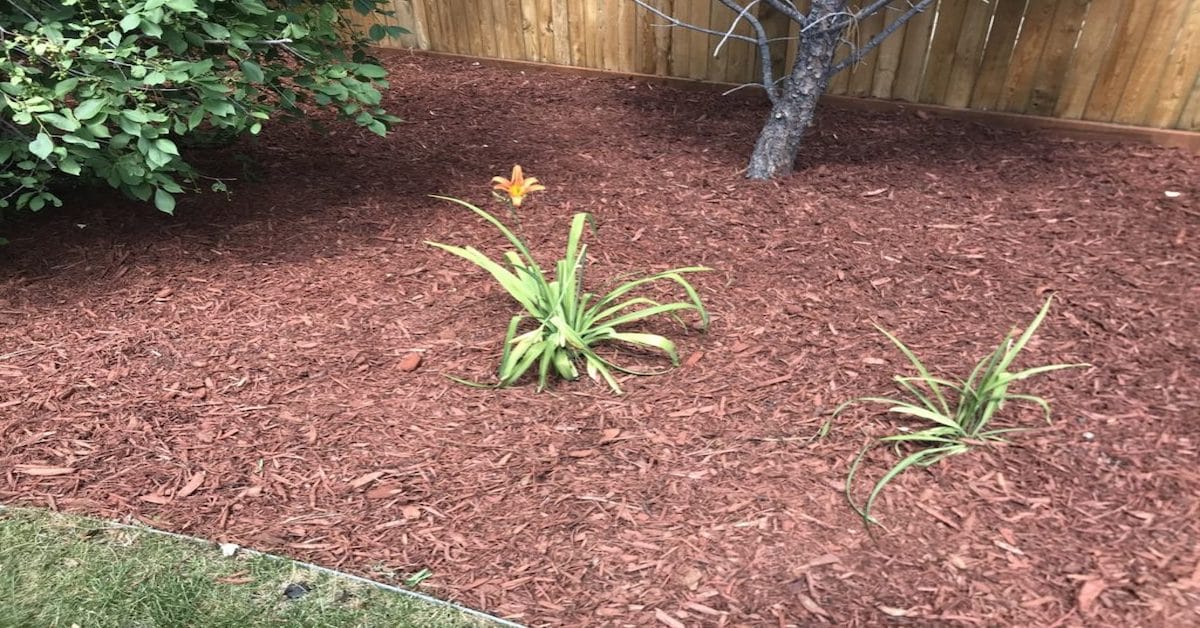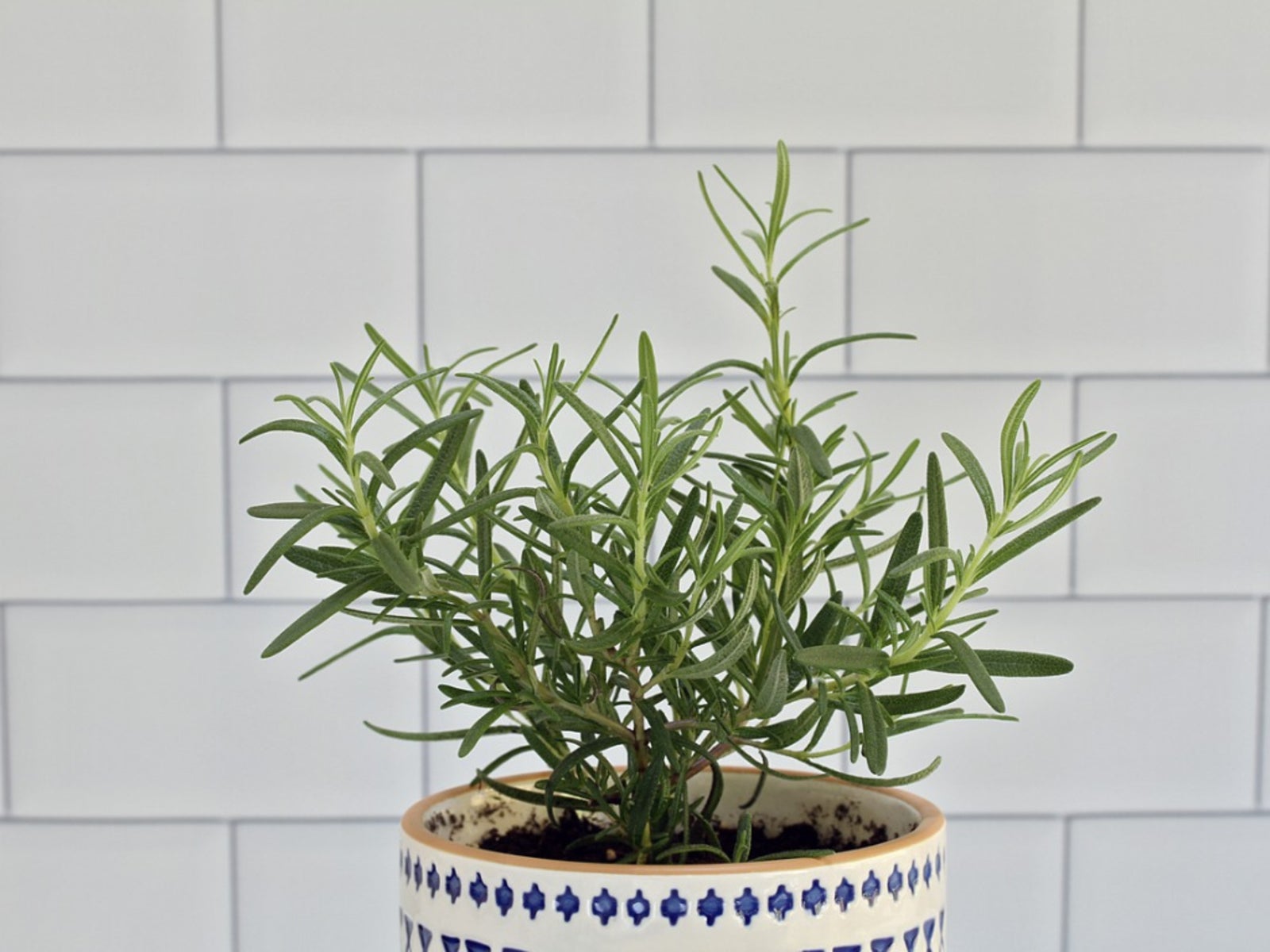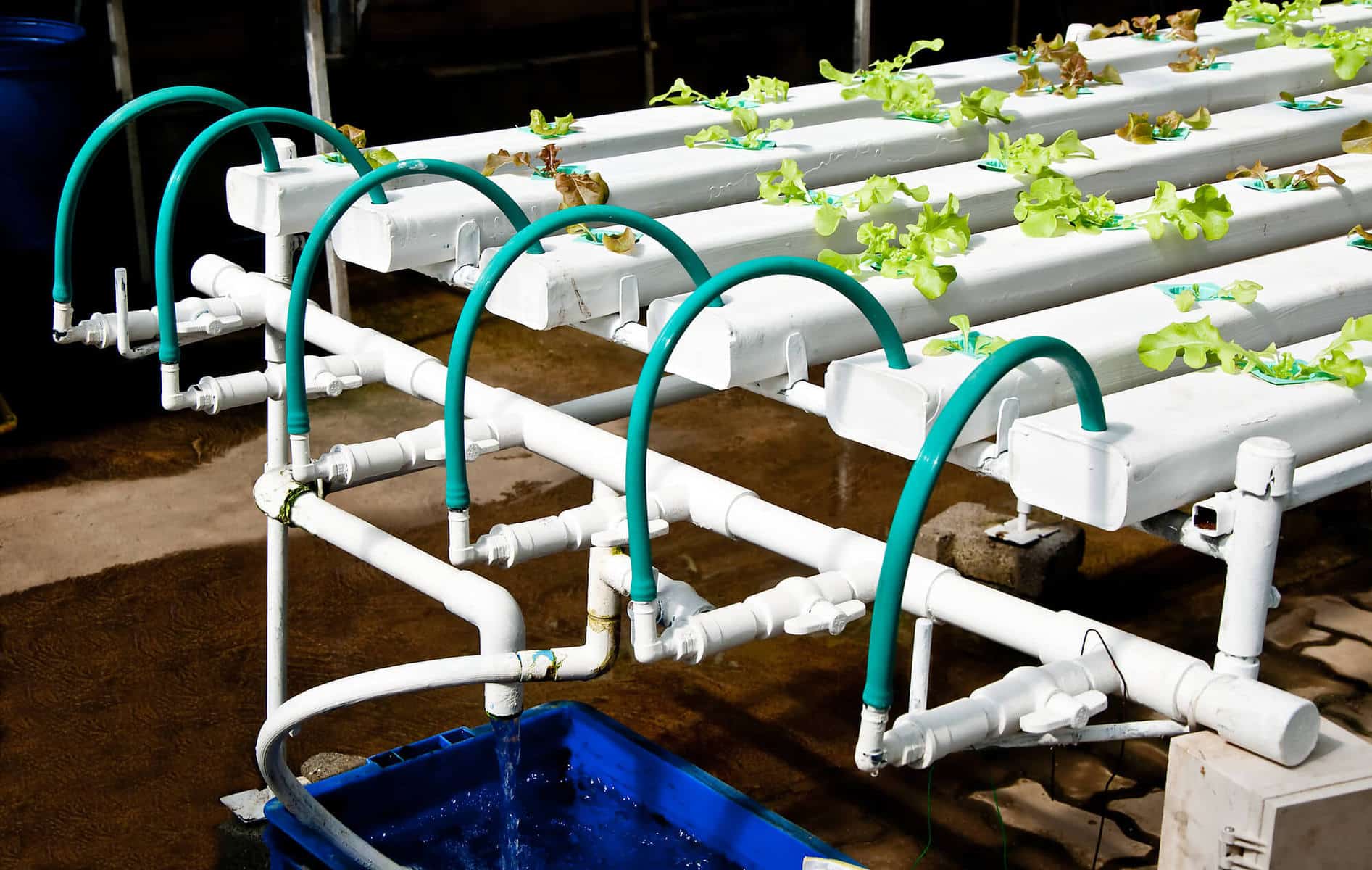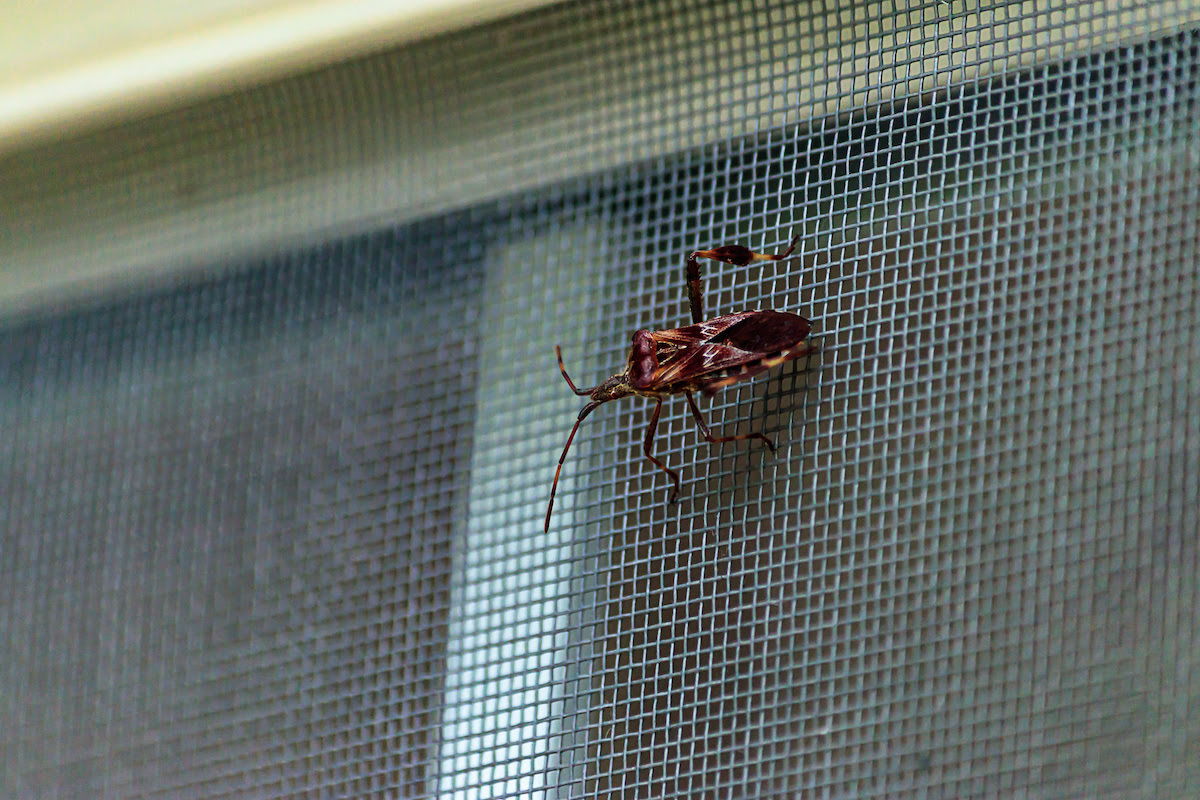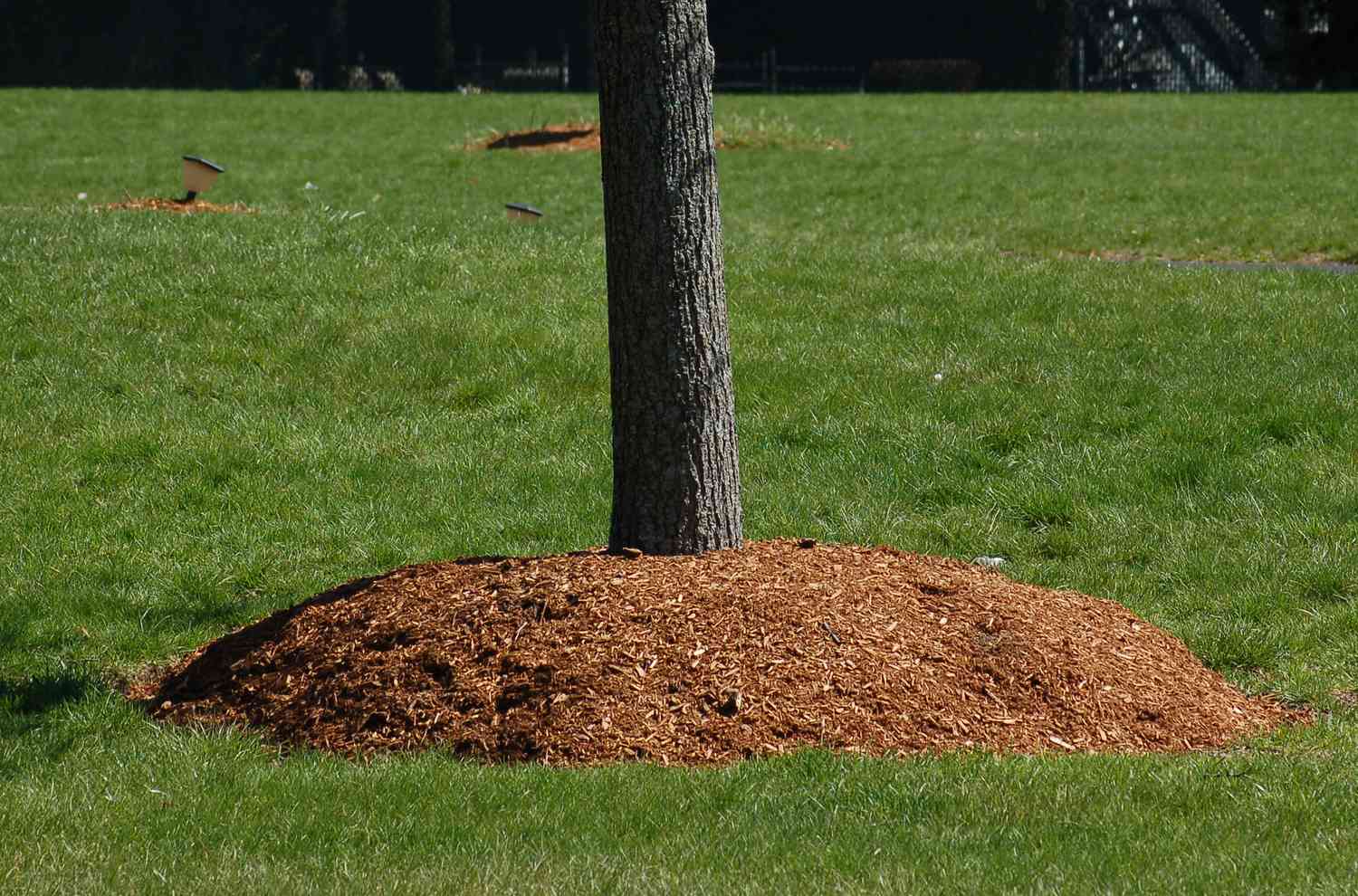Home>Gardening Basics>Getting Started>How Thick Does Mulch Need To Be To Prevent Weeds


Getting Started
How Thick Does Mulch Need To Be To Prevent Weeds
Published: December 16, 2023
"Getting Started: Discover the optimal thickness of mulch to effectively prevent weeds and promote healthy plant growth in your garden."
(Many of the links in this article redirect to a specific reviewed product. Your purchase of these products through affiliate links helps to generate commission for Chicagolandgardening.com, at no extra cost. Learn more)
Table of Contents
- Introduction
- What is mulch?
- The importance of preventing weeds
- Factors affecting the thickness of mulch required for weed prevention
- Optimal thickness of mulch for weed prevention
- Types of mulch that help prevent weeds
- Proper application techniques for mulch
- Benefits of using mulch to prevent weeds
- Common mistakes when using mulch for weed prevention
- Conclusion
Introduction
Welcome to the world of gardening, where maintaining a beautiful and healthy landscape is a constant battle against unwanted weeds. As any seasoned gardener knows, weeds can quickly take over your garden, competing with your precious plants for nutrients, sunlight, and space. To combat this relentless pest, one effective solution is the use of mulch.
Mulch is a protective layer of material that is spread over the soil surface to improve the growing conditions of plants. It not only helps retain moisture in the soil, but also regulates temperature, prevents erosion, and provides a barrier against weed growth. However, having the right thickness of mulch is crucial for its effectiveness in preventing weeds from emerging. So, how thick does mulch need to be to prevent weeds? Let’s delve into the world of mulch and explore the answer to this important question.
But first, let’s understand what exactly mulch is. Mulch can be made from a variety of organic and inorganic materials, such as wood chips, straw, bark, leaves, rocks, or rubber. It acts as a protective layer on the soil surface, creating a barrier between the sunlight and the weed seeds that lie dormant in the soil. By blocking the sunlight, mulch prevents weed seeds from germinating and growing.
Now, you might be wondering why preventing weeds is so important in the first place. Well, weeds not only compete with your plants for resources, but they can also harbor pests and diseases, reducing the overall health and vigor of your garden. Therefore, it’s essential to take proactive measures to prevent weed growth.
The thickness of mulch required for effective weed prevention can vary depending on several factors, which we will explore in the next section. By understanding these factors, you’ll be able to determine the optimal thickness of mulch for your specific garden and weed prevention needs. So, let’s dig deeper into the world of mulch and weed prevention.
What is mulch?
Mulch is a material that is applied to the surface of the soil in gardens, flower beds, or landscapes. Its primary purpose is to improve soil conditions and provide various benefits to plants. Mulch can be made from organic materials such as wood chips, straw, leaves, or bark, as well as inorganic materials like rocks or rubber. It serves as a protective layer that preserves moisture, regulates temperature, prevents erosion, and suppresses weed growth.
Organic mulch, such as wood chips or straw, decomposes over time, adding valuable organic matter to the soil. This breakdown process enriches the soil by increasing its fertility and improving its structure. Inorganic mulch, like rocks or rubber, does not break down and generally lasts longer, requiring less frequent replacement.
Mulch offers several benefits to plants and soil. First and foremost, it helps conserve moisture by reducing evaporation from the soil surface. By keeping the soil moist, mulch aids in the establishment and growth of plants, particularly during dry periods. This water conservation aspect makes mulch an essential tool for water-wise gardening.
In addition to conserving moisture, mulch also regulates soil temperature. During hot summer months, mulch acts as an insulating layer, keeping the soil cooler and protecting plant roots from extreme heat. Similarly, in colder seasons, mulch acts as a protective blanket, insulating the soil and preventing freezing. This temperature regulation contributes to healthier plants and improved overall garden performance.
Another advantage of mulch is the prevention of soil erosion. Mulch acts as a physical barrier, reducing soil erosion caused by heavy rain or wind. It helps to anchor the soil particles in place, preventing them from being washed away or blown off by strong gusts. This protection is particularly beneficial on slopes or in areas prone to erosion.
One of the significant benefits of mulch is its ability to suppress weed growth. By forming a barrier between the soil surface and sunlight, mulch inhibits the germination and growth of weed seeds. This suppression reduces competition for resources, such as water and nutrients, ensuring that your plants have a better chance of thriving without being overwhelmed by invasive weeds.
In summary, mulch is a versatile and valuable tool in gardening. Its multiple benefits, including moisture conservation, temperature regulation, erosion control, and weed suppression, make it an essential part of maintaining a healthy and attractive garden. Now that we understand the basics of mulch, let’s explore the factors that affect the thickness of mulch required for effective weed prevention in the next section.
The importance of preventing weeds
Weeds, those pesky unwanted plants that seem to pop up everywhere, can wreak havoc on your garden and landscape. They compete with your desired plants for resources such as water, nutrients, and sunlight, stunting their growth and reducing their overall vigor. Therefore, preventing weeds from taking root and spreading is essential for a successful and thriving garden. Let’s explore the importance of weed prevention and why it should be a priority in your gardening efforts.
First and foremost, preventing weeds saves you time and effort. Weeds grow rapidly, and if left unchecked, they can quickly take over your garden, transforming it from a well-tended space into a wild and tangled mess. Removing established weeds is a labor-intensive task that can be time-consuming and frustrating. By proactively preventing weeds, you can minimize the need for manual weed removal and spend more time enjoying your garden.
In addition to saving time, weed prevention also saves resources. Weeds compete with your desired plants for essential resources, such as water and nutrients. This competition can lead to reduced yields and poor plant health. By preventing weeds, you can ensure that your plants receive the necessary resources to thrive, resulting in healthier and more productive garden beds.
Weeds are not only resource thieves but can also harbor pests and diseases. They provide a haven for insects, fungi, and other pathogens, which can then spread to your desired plants. This can lead to plant damage or even complete crop loss. By preventing weeds, you reduce the risk of pest infestations and disease outbreaks, promoting the overall health and resilience of your garden.
Furthermore, weed prevention contributes to the long-term sustainability and environmental health of your garden. Weeds often have extensive root systems that can disrupt the soil structure and deplete soil moisture. This can lead to soil erosion, nutrient leaching, and reduced soil fertility over time. By keeping weeds at bay, you preserve the health and integrity of your soil, creating a fertile and optimal growing environment for your plants.
Last but not least, weed prevention is an important aspect of maintaining the aesthetic appeal of your garden. Weeds can quickly detract from the beauty and visual impact of your carefully designed landscape. By keeping weeds under control, you can showcase the beauty of your plants and create a well-maintained and visually stunning garden that you can take pride in.
In summary, preventing weeds is crucial for the success, health, and beauty of your garden. It saves you time and effort, conserves resources, reduces the risk of pests and diseases, promotes environmental sustainability, and enhances the overall visual appeal of your landscape. Now that we recognize the importance of weed prevention, let’s dive into the factors that influence the thickness of mulch required for effective weed prevention.
Factors affecting the thickness of mulch required for weed prevention
When it comes to using mulch to prevent weeds, the thickness of the mulch layer plays a crucial role in its effectiveness. The appropriate thickness ensures that weed seeds are deprived of the light they need to germinate and grow. However, several factors can influence the thickness of mulch required for effective weed prevention. Let’s take a closer look at these factors and understand their significance in determining the optimal mulch thickness.
1. Type of mulch: Different types of mulch have varying densities and properties. Organic mulches, such as wood chips or straw, tend to settle and decompose over time, reducing the overall thickness. In contrast, inorganic mulches like rocks or rubber maintain their original thickness for longer periods. The type of mulch you choose will impact the initial thickness required for weed prevention.
2. Weed species: The type and aggressiveness of the weed species present in your garden can influence the thickness of mulch needed. Some weeds have larger and more persistent seeds that require a thicker mulch layer to block their access to sunlight. It is essential to identify the dominant weed species in your garden and adjust the mulch thickness accordingly.
3. Stage of weed growth: The growth stage of weeds at the time of mulching can also affect the required thickness of mulch. If weeds have already germinated and emerged, a thicker mulch layer may be needed to suppress their growth and prevent further seed germination. On the other hand, if the weeds have not yet sprouted, a slightly thinner mulch layer may be sufficient for prevention.
4. Climate and weather conditions: The climate in your area, including factors such as temperature, rainfall, and sunlight intensity, can impact the thickness of mulch needed for weed prevention. In hotter and drier climates, a thicker layer of mulch can help conserve moisture and provide additional insulation for plants. In regions with heavy rainfall, a thicker mulch layer is necessary to prevent erosion and ensure effective weed suppression.
5. Soil type: The composition and structure of your soil can influence the mulch thickness required for weed prevention. For example, sandy soils may require a thicker layer of mulch to retain moisture and suppress weed growth, while clay soils may benefit from a slightly thinner layer to prevent excessive moisture retention and potential root rot.
Consider these factors when determining the thickness of mulch needed for effective weed prevention in your garden. Making adjustments based on these variables will help ensure that your mulch layer provides optimal suppression of weed growth and promotes the health and vitality of your desired plants.
Optimal thickness of mulch for weed prevention
Now that we understand the factors that can influence the thickness of mulch required for effective weed prevention, let’s delve into determining the optimal thickness for your specific garden. While the ideal mulch thickness may vary depending on the specific circumstances and preferences, there are some general guidelines to consider.
As a general rule of thumb, a mulch layer that is around 2 to 4 inches thick is often sufficient for most gardens. This thickness provides a barrier that blocks sunlight from reaching weed seeds in the soil, preventing germination and subsequent growth. However, in some cases, such as high weed pressure areas or windy conditions, a thicker layer of mulch may be necessary to provide enhanced weed suppression.
It is important to note that when applying mulch, more is not always better. Applying mulch that is too thick can lead to issues such as excess moisture retention, root suffocation, or the development of mold and fungal growth. It can also prevent air circulation, reducing oxygen availability to plant roots. Therefore, it is crucial to strike a balance and avoid over-mulching.
When determining the optimal mulch thickness, consider the factors we discussed earlier. Assess the type of mulch you are using, the dominant weed species in your garden, the growth stage of weeds, and the specific climate and soil conditions. Adjust the mulch thickness accordingly to account for these variables.
It is worth mentioning that maintaining the mulch layer’s thickness is an ongoing process. Over time, organic mulches will break down and compress, which may require additional mulch to be applied to maintain the desired thickness. Periodically check the mulch layer and replenish it as needed.
Lastly, ensure that the mulch layer is evenly spread and covers the entire area where weed suppression is desired. Gaps or thin spots in the mulch can provide opportunities for weed seeds to receive sunlight and germinate. Additionally, be mindful of keeping the mulch layer away from the stems or trunks of plants to avoid excessive moisture retention or potential rotting.
Remember, finding the optimal mulch thickness for weed prevention may require some experimentation and observation. Monitor the performance of your mulch layer and make adjustments as necessary to strike the right balance between weed suppression, moisture conservation, and plant health.
By determining and maintaining the optimal mulch thickness for your garden, you can effectively prevent weeds, promote the health and vigor of your desired plants, and enjoy a beautiful and low-maintenance landscape.
Types of mulch that help prevent weeds
When it comes to preventing weeds, choosing the right type of mulch can make a significant difference. Certain types of mulch have natural properties or characteristics that help suppress weed growth more effectively. Let’s explore some common types of mulch that are known for their weed prevention abilities.
1. Organic Mulch:
- Wood chips or bark mulch: These are popular choices for weed prevention due to their ability to create a dense and long-lasting mulch layer. They provide excellent weed suppression by blocking sunlight and forming a physical barrier that inhibits weed growth.
- Straw: Straw mulch is a natural and biodegradable option that is effective at preventing weed seeds from reaching the soil surface. It can be particularly beneficial for vegetable gardens or areas with a high need for nutrient cycling.
2. Landscape Fabric:
- Landscape fabric, also known as weed fabric or weed barrier, is a synthetic material that is laid beneath mulch to create an additional layer of weed prevention. It acts as a physical barrier, preventing weed growth by blocking sunlight and impeding the penetration of weed roots into the soil. However, it is essential to ensure proper installation to avoid nutrient and water limitations for your desired plants.
3. Gravel or Rock Mulch:
- Gravel or rock mulch is an inorganic option that provides long-lasting weed prevention. Its weight and density make it difficult for weed seeds to germinate and penetrate the soil. Additionally, it offers excellent water drainage, which can be beneficial in preventing excessive moisture accumulation.
4. Rubber Mulch:
- Rubber mulch, made from recycled tires, is a durable and long-lasting option that effectively reduces weed growth. Its dense composition and dark color help to create a barrier against sunlight, inhibiting weed germination and growth. Rubber mulch is also beneficial for moisture retention and insulation in various climates.
5. Newspaper or Cardboard:
- Newspaper or cardboard sheets can be used as temporary weed barriers under mulch. These materials smother weeds by preventing sunlight penetration and breaking down over time. They are an organic and cost-effective way to suppress weeds while allowing for nutrient cycling in the soil.
When selecting mulch for weed prevention, consider the specific needs and conditions of your garden. The type of mulch you choose should align with your preferences, available resources, and the overall aesthetic you desire. It’s important to note that no mulch is entirely weed-proof, and some weeds may still find their way through the mulch layer. However, by selecting the appropriate mulch type and maintaining the recommended thickness, you can significantly reduce weed infestations and create a more manageable and beautiful landscape.
Proper application techniques for mulch
Applying mulch correctly is key to maximizing its effectiveness in weed prevention and providing optimal benefits to your garden. Follow these proper application techniques to ensure that your mulch creates an effective barrier against weeds while promoting the health and vitality of your plants.
1. Prepare the area: Before applying mulch, remove any existing weeds or grass from the area. This helps prevent weed regrowth beneath the mulch layer and ensures that the mulch can make direct contact with the soil surface.
2. Clean and weed-free surface: Ensure that the soil surface is clean and free of any debris or large rocks that may interfere with the mulch application. Also, remove any existing weeds or unwanted plants to prevent them from reemerging through the mulch layer.
3. Apply a weed barrier: If desired, you can lay down a weed control fabric or newspaper/cardboard sheets as a base layer before applying the mulch. This additional barrier further hinders weed growth and helps conserve moisture in the soil. Make sure to properly secure the fabric or sheets to prevent shifting or exposure.
4. Determine the appropriate thickness: As we discussed earlier, consider the factors that influence mulch thickness, such as the type of mulch, weed species, and climate. Aim for a thickness of around 2 to 4 inches, ensuring consistent coverage but avoiding excessive depth that can lead to moisture retention or other issues.
5. Spread mulch evenly: Distribute the mulch evenly across the desired area. Use a rake or garden fork to spread the mulch layer, ensuring it extends to the edges of your garden beds or landscape. Be mindful not to pile mulch against the stems or trunks of plants, as this can lead to excess moisture retention or the development of rot and disease.
6. Maintain mulch depth: Over time, organic mulches will decompose and settle, reducing their thickness. Periodically monitor the mulch layer and replenish it as needed to maintain the desired thickness and weed prevention effectiveness. Add a new layer of mulch when the existing layer becomes thin or compacted.
7. Edging and maintenance: To create a clean and polished look, consider installing edging materials, such as plastic, metal, or stone, to separate the mulched area from the surrounding lawn or walkways. This helps keep the mulch contained and prevents it from spilling over onto undesired areas.
By following these proper application techniques, you can ensure that your mulch layer is applied correctly, creating an effective barrier against weeds, conserving moisture, and promoting a visually appealing landscape for your garden.
Benefits of using mulch to prevent weeds
Using mulch as a weed prevention strategy offers numerous benefits beyond just suppressing weed growth. Let’s explore the advantages of using mulch to prevent weeds in your garden and how it can contribute to the overall health and beauty of your landscape.
1. Weed suppression: The primary benefit of using mulch is its ability to suppress weed growth. By creating a barrier on the soil surface, mulch blocks sunlight from reaching weed seeds, preventing their germination and subsequent growth. This suppression reduces the need for manual weeding, saves time and effort in garden maintenance, and ensures that your desired plants have a competitive advantage for resources, such as water and nutrients.
2. Moisture conservation: Mulch acts as a protective layer that helps conserve moisture in the soil. It reduces evaporation by creating a barrier against direct sunlight and wind exposure. This moisture retention is particularly beneficial during hot and dry periods, as it reduces the need for frequent watering and helps plants withstand drought stress. Additionally, mulch prevents rapid soil moisture fluctuation, promoting stable moisture levels for optimal plant health.
3. Temperature regulation: Mulch provides an insulating layer on the soil surface, helping to regulate soil temperatures. It keeps the soil cooler during hot summer months, reducing the risk of root damage caused by extreme heat. Likewise, in colder seasons, mulch provides insulation, protecting plant roots from freezing temperatures. This temperature regulation contributes to healthier plants, improved root development, and overall garden performance.
4. Soil erosion prevention: One often-overlooked benefit of mulch is its role in preventing soil erosion. Mulch acts as a protective cover, reducing the impact of heavy rainfall and minimizing soil runoff. It helps to anchor soil particles in place, preventing them from being washed away or eroded by water or wind. This erosion prevention is particularly crucial on slopes or areas prone to erosion, ensuring the retention of valuable topsoil and preserving the structural integrity of the landscape.
5. Nutrient enrichment: Organic mulches, such as wood chips or straw, gradually break down over time, enriching the soil with organic matter. As these materials decompose, they release nutrients into the soil, improving its fertility and providing a continuous source of nutrition for your plants. This nutrient enrichment supports plant growth and overall soil health, reducing the need for additional fertilization.
6. Weed prevention in garden beds and pathways: Mulch is not limited to garden beds but can also be used in pathways and walkways. Applying mulch to these areas prevents the growth of weeds between pavers or stones, ensuring a clean and visually appealing pathway. This low-maintenance solution eliminates the need for frequent weeding, allowing you to enjoy your garden without the hassle of constant maintenance.
By using mulch to prevent weeds, you reap the benefits of weed suppression, moisture conservation, temperature regulation, erosion prevention, nutrient enrichment, and low-maintenance pathways. These advantages contribute to the overall health, sustainability, and beauty of your garden, making mulch a valuable tool for any gardener.
Common mistakes when using mulch for weed prevention
Mulch is a valuable tool for preventing weeds and improving the overall health of your garden. However, there are some common mistakes that gardeners make when using mulch for weed prevention. Being aware of these mistakes can help you avoid any potential issues and maximize the benefits of using mulch. Let’s explore some of these common mistakes:
1. Over-mulching: Using excessive amounts of mulch is a common mistake. While a thick layer of mulch is beneficial for weed prevention, using too much can lead to problems. Over-mulching can suffocate plant roots by blocking oxygen and water penetration, causing root rot and fungal diseases. It can also prevent essential rainwater from reaching the soil and result in excessive moisture retention, which can cause root rot and attract pests.
2. Mulch piled against plant stems: Another mistake is piling mulch against the stems or trunks of plants. This practice can trap moisture against the plant, leading to rotting and disease. It can also attract pests and provide a hiding place for insects. Leave a small gap around the base of plants to allow for proper air circulation and to prevent moisture-related issues.
3. Using the wrong type of mulch: Not all types of mulch are suitable for every garden. Using the wrong type of mulch can lead to issues such as nutrient imbalances, excessive acidity, or poor drainage. It’s essential to consider the specific needs of your plants and the characteristics of the mulch you choose. Research the different types of mulch available and select one that aligns with your gardening requirements.
4. Not preparing the area before mulching: Neglecting to prepare the area before applying mulch is a mistake that can lead to weed growth. Make sure the soil surface is clear of weeds, grass, or any debris before mulching. Removing existing weeds will help prevent them from reemerging through the mulch layer and competing with your desired plants.
5. Neglecting to replenish mulch: Over time, organic mulches will break down and decompose. Neglecting to replenish the mulch layer can lead to a reduction in its thickness and effectiveness in weed prevention. Monitor the mulch layer regularly and add a fresh layer when needed to maintain the desired thickness and maximize weed suppression.
6. Applying mulch too late or too early in the season: Timing is crucial when applying mulch for weed prevention. Applying mulch too early in the season can prevent the soil from warming up and delay plant growth. On the other hand, applying mulch too late can allow weeds to establish and compete with your desired plants. Apply mulch when the soil has warmed up, and after planting or emergence of desired plants, ensuring that the mulch layer covers the entire area effectively.
7. Not considering mulch depth variation: Mulch depth can vary across your garden due to factors such as wind, water runoff, or uneven application. Neglecting to address these variations can lead to inconsistent weed suppression. Regularly check the mulch depth and redistribute or replenish as needed to maintain a uniform layer for effective weed prevention.
By avoiding these common mistakes, you can maximize the benefits of using mulch for weed prevention. Proper mulch application, along with careful consideration of mulch type and maintenance, will help you create a healthy and beautiful garden free from unwanted weeds.
Conclusion
Mulch is a valuable tool in the fight against weeds, offering numerous benefits to your garden and landscape. By understanding the factors that influence the thickness of mulch required for weed prevention, you can make informed decisions about the type and amount of mulch needed in your specific gardening circumstances.
Choosing the right type of mulch, applying it correctly, and avoiding common mistakes are crucial in maximizing the effectiveness of mulch for weed prevention. Organic mulches, landscape fabric, gravel or rock mulch, rubber mulch, and newspaper/cardboard sheets are just some of the options available to gardeners looking to keep weeds at bay. Each type of mulch has its unique characteristics and benefits, so consider your specific needs and preferences when making your choice.
When applying mulch, ensure that the thickness is appropriate, evenly spread, and covers the entire desired area. Monitor mulch depth over time and replenish as needed to maintain optimal weed suppression. Avoid over-mulching or piling mulch against plant stems, as these practices can lead to root suffocation, excess moisture retention, and root rot.
Remember, mulch offers more than just weed prevention. It conserves moisture, regulates soil temperature, helps prevent erosion, enriches the soil with organic matter, and creates low-maintenance pathways. By incorporating mulch into your gardening routine, you can create a healthier, more sustainable, and visually appealing landscape.
So, whether you’re a seasoned gardener or just starting out, mulch can be a valuable ally in your weed prevention efforts. Take the time to research and choose the right mulch for your garden, apply it properly, and regularly maintain the mulch layer for ongoing weed prevention. With these practices in place, you can enjoy a flourishing garden with fewer weeds and more time to appreciate its beauty.
